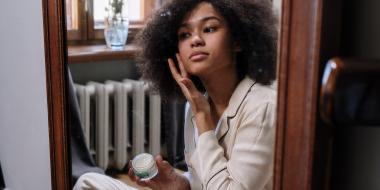Babies enter the world with perfect skin. The expression “smooth as a baby’s bottom” rings true as there is really nothing comparable to it. We take great pains to protect this pelt - covering it with the softest of fabrics, bathing it in specially formulated bubbles and tenderly applying lotions and balms. But sometimes, despite our best efforts, children can end up with a stubborn skin condition. Find out how to treat the most common childhood skin conditions.
The skin is a complicated organ with many layers, functions and purposes. It eliminates toxins, regulates temperature, absorbs vitamin D and protects the body from pathogens and pollutants. It’s no wonder that it can easily be thrown out of whack in some children. The solutions can also be a complicated matter because there are so many things to consider – from toxins to irritants to allergies – so when it comes to babies and children, a gentle, natural approach is the ideal solution for their developing skin.
Cradle Cap
Cradle cap is a very common form of seborrheic dermatitis on the scalp of newborns up to 3-month-olds. It’s basically baby dandruff characterized by dry, flaky, greasy, scaly skin. Fortunately it is not painful or itchy, though it sure looks like it would be. It’s caused by a yeast/fungal overgrowth that thrives in oily conditions so it needs to be treated with something that will impede this growth. A great option is virgin coconut oil (the solid rather than the fractionated liquid version) because its high amount of lauric acid contains anti-fungal properties. Apply the oil directly to skin after gently scrubbing with a washcloth.
Eczema
Eczema, also known as atopic dermatitis, is inflammation characterized by dry, flaky, red, itchy, and oozing skin. It is the most common skin disorder in the world and affects 12% to 25% of children. There is no known cause of or cure for it but we do know that it involves a breakdown in the protective barrier (acid mantle) of the epidermis. The acid mantle is a thin layer of bacteria, lipids and sebum that neutralizes harmful microbes and helps to lock moisture in. When this hardworking gatekeeper is compromised, allergens and pathogens can enter and hydration is not retained. Current research suggests that a combination of genetic, immune system and environmental factors can lead to a flare up. We may not be able to target the genes but we can certainly look at the things that children are exposed to that may contribute to this common skin condition.
From day one, many babies are exposed to harsh detergents known to disrupt barrier function. Hospitals typically use commercial baby washes on newborns, bombarding their sensitive skin with chemicals that can disrupt the PH balance and strip it of its protective abilities. We then bathe our babies daily with these products and the notion that they are gentle and safe because that’s how they are marketed but it is actually recommended that children with eczema only be bathed 3 times per week. It’s important to avoid all harsh detergents, which are in most commercial cleansers, body washes, shampoos and hand soaps. Look for more gentle versions such as natural soap, liquid castile or even gentle washes with detergents like glucosides. You can even make your own non-toxic baby care products!
Contributors to eczema flare-ups
- Environmental pollutants such as synthetic household products, pesticides, dust mites, car exhaust and pet dander
- Winter conditions such as cold temperatures, dry indoor air and lack of vitamin D
- Exposure to bacteria such as Staphylococcus aureus
- Food allergies
- Reactions to drugs
- Stress
Treatment options remain limited. Children are often prescribed topical steroids and antibiotics, which are not a long term solution and usually stop working after a period of time. It needs a more holistic approach that takes several things into consideration. As Jennifer Forristal, ND, puts it, “The skin is our biggest organ of detoxification and tells us a lot about what is going on inside the body, if we take the time to listen. Instead of suppressing childhood eczema with commonly used steroid creams, the aim is to address the root cause, which may range from digestive concerns and allergies to stress. The great news is that once we have identified the cause there are many gentle and effective treatments that can improve childhood eczema and treating it from the inside out will not only improve your child’s skin but their overall health. Many interventions such as rebalancing the good bacteria in the gut or taking omega-3 fats have shown to be helpful in treating this condition.”
For relief of eczema symptoms, soak in a bath of magnesium-rich Dead Sea salt. It will help repair barrier function and replenish minerals in the skin. Oatmeal baths are great for relief of itching and there are many essential oils that can soothe inflammation such as lavender, helichrysum and chamomile. You can strengthen the skin’s barrier by applying a thick moisturizer to the area. Your best bets are balms and ointments because they will sit on the skin. Look for natural, gentle versions rather than petrochemical-based ones, which can cause further inflammation.

Sunburn
While not arising from an internal condition, sun safety is a must for all ages. Our skin can tolerate some of the sun's rays but in the hours when the sun is strongest, between 10 AM and 2 PM, we should cover up with sunscreen, hats, shade, and clothing. In high doses, solar rays cause cellular damage that increases the risk of developing skin cancer. When overexposed, sunburn can occur which can be very painful and irritating with red, inflamed skin that may even peel off. The best way to treat sunburn is to put something anti-inflammatory on it such as aloe vera juice or gel. You can add a drop of peppermint essential oil to it to give the skin a cooling sensation and relieve pain. Once the initial redness subsides, moisturize it frequently with a natural lotion containing healing lavender, calendula or comfrey.
Teen and Pre-Teen Acne
Acne develops on skin when sebum, bacteria and dead skin cells get trapped in pores and create eruptions known as blackheads, pimples or zits that can be painful, scarring and a rotten thing to have when you’re already feeling self-conscious. It is quite common in teens and preteens because of hormonal changes experienced during this time and can be exacerbated by poor dietary choices, hygiene issues, stress and unsuitable skin care products.
There is no "cure all" for this chronic condition, even though there are ample offers in the skin care industry, as well as the prescribing of the birth control pill, which comes with its own issues. Some methods include blasting the skin with harsh ingredients that strip it of any excess oil and then applying antibiotics that will annihilate all bacteria, even the helpful kind. This approach can create more imbalances such as dry flakiness and inflamed redness.
A much better solution is to treat it with soothing ingredients such as the essential oils of tea tree (up to 5%) and lavender (up to 20%) as well as witch hazel distillate and white willow bark extract. These botanicals are antibacterial, anti-inflammatory and astringent (drying) but in a gentle manner. It is also important to exfoliate every second day with a natural scrub to clear dead skin cells and debris from the surface. A weekly clay mask will detox pores by drawing out pollutants. As hard as this might be to convince some teenagers, they must avoid heavy foundations that will further clog pores. A tinted moisturizer is a much better choice. Pimples should never be popped as it can lead to spreading and scarring. Absolutely no picking at the skin!
The root cause of acne is internal so a trip to the naturopath can prove to be very helpful in eliminating it from your teen’s life. Dr. Forristal takes a holistic approach, one that takes many things into consideration and says, “The teen years come with many shifts, not only in hormone levels, but nutrient intake, blood sugars and stress levels and these can have a big impact on the development of acne. Clear skin is a reflection of both how we care for our skin and the underlying terrain of our bodies. Simple adjustments in diet, supplements and lifestyle can have a big impact. As a naturopathic doctor, I am always working to leave my patients glowing from the inside out.”
Cold Sores
Cold sores are blister-like infections around the mouth caused by the herpes simplex virus, a contagion that never leaves the body once it enters. This virus lies dormant in the nervous system until a flare-up occurs, usually when the immune system is weakened from illness or stress. They can be difficult to treat and don’t go away on their own, at least not in a timely manner.
Essential oils such as bergamot, lemon balm, and tea tree can be used to target the virus but the most simple and accessible solution is fresh lemon. It sends the virus running with the active ingredient limonene. Lemon on its own will sting so add it to honey in a 1:6 ratio and you can help avoid future flare-ups by supporting the immune system with a healthy, relaxed lifestyle.
Skin conditions are usually a visual indicator of a deeper problem that refuses to be ignored, whether it’s an invading pathogen, an environmental irritant or avoidable food allergy. Treating the symptoms is not always the answer and is rarely a permanent solution, but finding a good, healthy treatment to ease the discomfort as you address the underlying cause is valuable. It can be a journey to find out what works for your child but a great place to start is with gentle, natural ingredients that are meant for your skin as well as the care of a holistic practitioner who will take many things into consideration when creating a treatment plan.






